Tracking the green invaders advances in imaging virus infection in plants
- 格式:pdf
- 大小:1.17 MB
- 文档页数:17
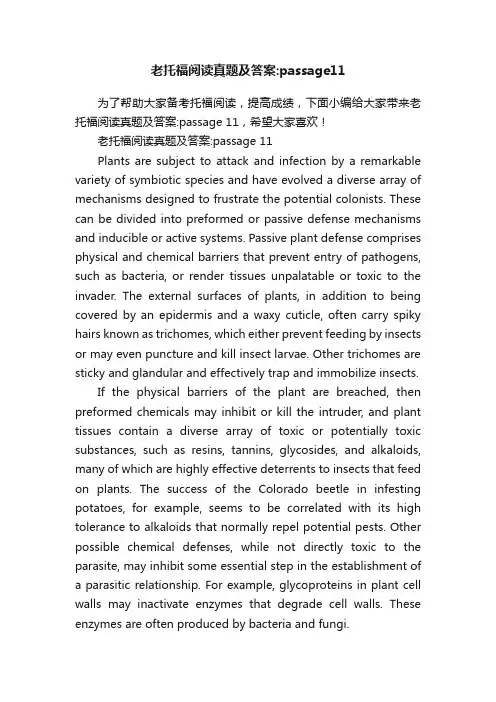
老托福阅读真题及答案:passage11为了帮助大家备考托福阅读,提高成绩,下面小编给大家带来老托福阅读真题及答案:passage 11,希望大家喜欢!老托福阅读真题及答案:passage 11Plants are subject to attack and infection by a remarkable variety of symbiotic species and have evolved a diverse array of mechanisms designed to frustrate the potential colonists. These can be divided into preformed or passive defense mechanisms and inducible or active systems. Passive plant defense comprises physical and chemical barriers that prevent entry of pathogens, such as bacteria, or render tissues unpalatable or toxic to the invader. The external surfaces of plants, in addition to being covered by an epidermis and a waxy cuticle, often carry spiky hairs known as trichomes, which either prevent feeding by insects or may even puncture and kill insect larvae. Other trichomes are sticky and glandular and effectively trap and immobilize insects.If the physical barriers of the plant are breached, then preformed chemicals may inhibit or kill the intruder, and plant tissues contain a diverse array of toxic or potentially toxic substances, such as resins, tannins, glycosides, and alkaloids, many of which are highly effective deterrents to insects that feed on plants. The success of the Colorado beetle in infesting potatoes, for example, seems to be correlated with its high tolerance to alkaloids that normally repel potential pests. Other possible chemical defenses, while not directly toxic to the parasite, may inhibit some essential step in the establishment of a parasitic relationship. For example, glycoproteins in plant cell walls may inactivate enzymes that degrade cell walls. These enzymes are often produced by bacteria and fungi.Active plant defense mechanisms are comparable to the immune system of vertebrate animals, although the cellular and molecular bases are fundamentally different. Both, however, are triggered in reaction to intrusion, implying that the host has some means of recognizing the presence of a foreign organism. The most dramatic example of an inducible plant defense reaction is the hypersensitive response. In the hypersensitive response, cells undergo rapid necrosis — that is, they become diseased and die —after being penetrated by a parasite; the parasite itself subsequently ceases to grow and is therefore restricted to one or a few cells around the entry site. Several theories have been put forward to explain the basis of hypersensitive resistance.1. What does the passage mainly discuss?(A) The success of parasites in resisting plant defense mechanisms(B) Theories on active plant defense mechanisms(C) How plant defense mechanisms function(D) How the immune system of animals and the defense mechanisms of plants differ2. The phrase "subject to" in line 1 is closest in meaning to(A) susceptible to(B) classified by(C) attractive to(D) strengthened by3. The word "puncture" in line 8 is closest in meaning to(A) pierce(B) pinch(C) surround(D) cover .4. The word "which" in line 12 refers to(A) tissues(B) substances(C) barriers(D) insects5. Which of the following substances does the author mention as NOT necessarily being toxic to the Colorado beetle?(A) resins(B) tannins(C) glycosides(D) alkaloids6. Why does the author mention "glycoproteins" in line 17?(A) to compare plant defense mechanisms to the immune system of animals(B) to introduce the discussion of active defense mechanisms in plants(C) to illustrate how chemicals function in plant defense(D) to emphasize the importance of physical barriers in plant defense7. The word "dramatic" in line 23 could best be replaced by(A) striking(B) accurate(C) consistent(D) appealing8. Where in the passage does the author describe an active plant-defense reaction?(A) Lines 1-3(B) Lines 4-6(C) Lines 13-15(D) Lines 24-279. The passage most probably continues with a discussion of theories on(A) the basis of passive plant defense(B) how chemicals inhibit a parasitic relationship.(C) how plants produce toxic chemicals(D) the principles of the hypersensitive response.正确答案:CAABD CADD托福阅读易错词汇的整理1) quite 相当 quiet 安静地2) affect v 影响, 假装 effect n 结果, 影响3) adapt 适应 adopt 采用 adept 内行4) angel 天使 angle 角度5) dairy 牛奶厂 diary 日记6) contend 奋斗, 斗争content 内容, 满足的context 上下文contest 竞争, 比赛7) principal 校长, 主要的 principle 原则8) implicit 含蓄的 explicit 明白的9) dessert 甜食 desert 沙漠 v 放弃 dissert 写论文10) pat 轻拍 tap 轻打 slap 掌击 rap 敲,打11) decent 正经的 descent n 向下, 血统 descend v 向下12) sweet 甜的 sweat 汗水13) later 后来 latter 后者 latest 最近的 lately adv 最近14) costume 服装 custom 习惯15) extensive 广泛的 intensive 深刻的16) aural 耳的 oral 口头的17) abroad 国外 aboard 上(船,飞机)18) altar 祭坛 alter 改变19) assent 同意 ascent 上升 accent 口音20) champion 冠军 champagne 香槟酒 campaign 战役21) baron 男爵 barren 不毛之地的 barn 古仓22) beam 梁,光束 bean 豆 been have 过去式23) precede 领先 proceed 进行,继续24) pray 祈祷 prey 猎物25) chicken 鸡 kitchen 厨房26) monkey 猴子 donkey 驴27) chore 家务活 chord 和弦 cord 细绳28) cite 引用 site 场所 sight 视觉29) clash (金属)幢击声 crash 碰幢,坠落 crush 压坏30) compliment 赞美 complement 附加物31) confirm 确认 conform 使顺从32) contact 接触 contract 合同 contrast 对照33) council 议会 counsel 忠告 consul 领事34) crow 乌鸦 crown 王冠 clown 小丑 cow 牛35) dose 一剂药 doze 打盹36) drawn draw 过去分词 drown 溺水托福阅读学术词汇的解析什么是学术词汇在托福阅读的课堂上,经常有学生对繁杂的学术词汇头疼不已。
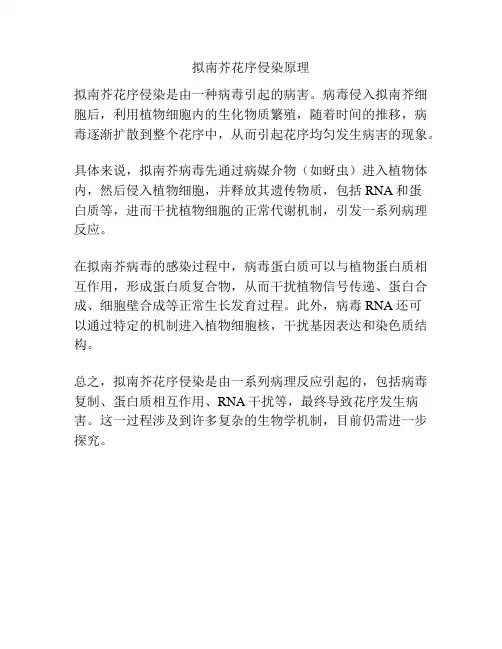
拟南芥花序侵染原理
拟南芥花序侵染是由一种病毒引起的病害。
病毒侵入拟南芥细胞后,利用植物细胞内的生化物质繁殖,随着时间的推移,病毒逐渐扩散到整个花序中,从而引起花序均匀发生病害的现象。
具体来说,拟南芥病毒先通过病媒介物(如蚜虫)进入植物体内,然后侵入植物细胞,并释放其遗传物质,包括RNA和蛋
白质等,进而干扰植物细胞的正常代谢机制,引发一系列病理反应。
在拟南芥病毒的感染过程中,病毒蛋白质可以与植物蛋白质相互作用,形成蛋白质复合物,从而干扰植物信号传递、蛋白合成、细胞壁合成等正常生长发育过程。
此外,病毒RNA还可
以通过特定的机制进入植物细胞核,干扰基因表达和染色质结构。
总之,拟南芥花序侵染是由一系列病理反应引起的,包括病毒复制、蛋白质相互作用、RNA干扰等,最终导致花序发生病害。
这一过程涉及到许多复杂的生物学机制,目前仍需进一步探究。
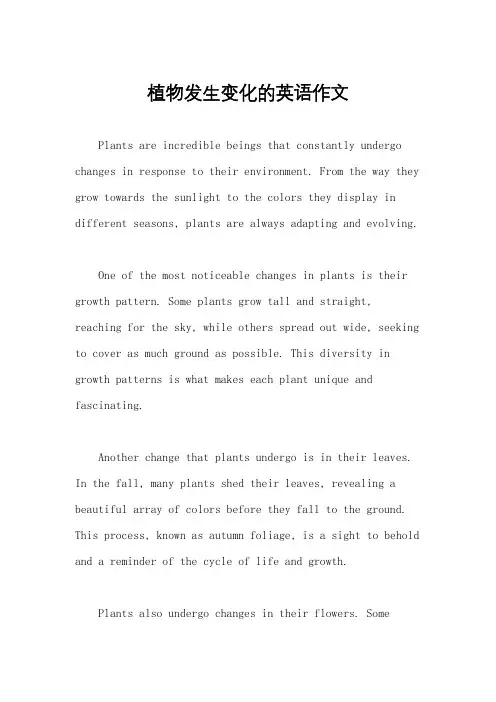
植物发生变化的英语作文Plants are incredible beings that constantly undergo changes in response to their environment. From the way they grow towards the sunlight to the colors they display in different seasons, plants are always adapting and evolving.One of the most noticeable changes in plants is their growth pattern. Some plants grow tall and straight, reaching for the sky, while others spread out wide, seeking to cover as much ground as possible. This diversity in growth patterns is what makes each plant unique and fascinating.Another change that plants undergo is in their leaves. In the fall, many plants shed their leaves, revealing a beautiful array of colors before they fall to the ground. This process, known as autumn foliage, is a sight to behold and a reminder of the cycle of life and growth.Plants also undergo changes in their flowers. Someplants bloom brightly and attract pollinators with their vibrant colors and sweet scents, while others produce inconspicuous flowers that rely on the wind for pollination. The diversity in flower types is a testament to theingenuity of plants in ensuring their reproduction.In addition to physical changes, plants also undergo changes in their metabolism. They produce oxygen during photosynthesis, which is essential for all living beings, and they absorb carbon dioxide, helping to regulate the Earth's atmosphere. This metabolic process is crucial forthe survival of plants and the balance of the ecosystem.Overall, plants are constantly changing and adapting to their environment in order to survive and thrive. Their ability to undergo such diverse and complex changes is a testament to the resilience and beauty of the natural world.。
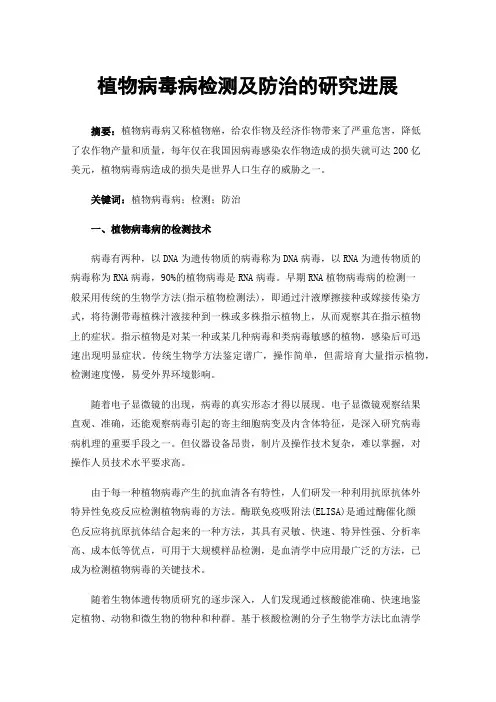
植物病毒病检测及防治的研究进展摘要:植物病毒病又称植物癌,给农作物及经济作物带来了严重危害,降低了农作物产量和质量,每年仅在我国因病毒感染农作物造成的损失就可达200亿美元,植物病毒病造成的损失是世界人口生存的威胁之一。
关键词:植物病毒病;检测;防治一、植物病毒病的检测技术病毒有两种,以DNA为遗传物质的病毒称为DNA病毒,以RNA为遗传物质的病毒称为RNA病毒,90%的植物病毒是RNA病毒。
早期RNA植物病毒病的检测一般采用传统的生物学方法(指示植物检测法),即通过汁液摩擦接种或嫁接传染方式,将待测带毒植株汁液接种到一株或多株指示植物上,从而观察其在指示植物上的症状。
指示植物是对某一种或某几种病毒和类病毒敏感的植物,感染后可迅速出现明显症状。
传统生物学方法鉴定谱广,操作简单,但需培育大量指示植物,检测速度慢,易受外界环境影响。
随着电子显微镜的出现,病毒的真实形态才得以展现。
电子显微镜观察结果直观、准确,还能观察病毒引起的寄主细胞病变及内含体特征,是深入研究病毒病机理的重要手段之一。
但仪器设备昂贵,制片及操作技术复杂,难以掌握,对操作人员技术水平要求高。
由于每一种植物病毒产生的抗血清各有特性,人们研发一种利用抗原抗体外特异性免疫反应检测植物病毒的方法。
酶联免疫吸附法(ELISA)是通过酶催化颜色反应将抗原抗体结合起来的一种方法,其具有灵敏、快速、特异性强、分析率高、成本低等优点,可用于大规模样品检测,是血清学中应用最广泛的方法,已成为检测植物病毒的关键技术。
随着生物体遗传物质研究的逐步深入,人们发现通过核酸能准确、快速地鉴定植物、动物和微生物的物种和种群。
基于核酸检测的分子生物学方法比血清学方法具有更宽的检测范围、更高的灵敏度、更强的特异性,适用于大批量样本检测,在植物病毒检测中得到了迅速而广泛的应用。
包括核酸杂交技术(Nucleic acid hybridiza-tion)、反转录PCR技术(RT-PCR)、荧光定量PCR技术(real-timePCR)、DNA微阵列技术(DNA microarray)。

侵染葫芦科作物的甜瓜黄斑病毒研究进展一、引言葫芦科作物在全球农业中占据着重要地位,包括西瓜、甜瓜、黄瓜等。
然而,甜瓜黄斑病毒(Melon yellow spot virus,MYSV)的出现给这些作物的生产带来了严重威胁。
MYSV 是一种近年来备受关注的植物病毒,其侵染机制、传播途径以及防控策略等方面的研究不断取得新的进展。
二、甜瓜黄斑病毒的生物学特性MYSV 属于布尼亚病毒科(Bunyaviridae)成员,病毒粒子呈球形,具有包膜。
其基因组由 RNA 片段组成,分别编码不同的功能蛋白。
这些蛋白在病毒的复制、装配和侵染过程中发挥着关键作用。
该病毒寄主范围较广,除了侵染甜瓜外,还能感染西瓜、黄瓜、南瓜等多种葫芦科作物。
不同寄主上的症状表现有所差异,甜瓜上常出现黄斑、坏死斑,严重时导致叶片干枯;西瓜上则可能出现叶片黄化、果实畸形等症状。
三、甜瓜黄斑病毒的传播途径MYSV 主要通过介体昆虫传播,蓟马是其主要的传播媒介。
蓟马在吸食感染病毒的植株汁液后,携带病毒并在后续的取食过程中传播给健康植株。
此外,农事操作中的工具传播、种苗携带病毒传播等途径也可能在一定程度上促进了病毒的扩散。
四、甜瓜黄斑病毒的侵染机制当蓟马将病毒传播到健康植株后,病毒通过寄主的伤口或气孔进入细胞。
随后,病毒的基因组在寄主细胞内进行复制和转录,合成新的病毒粒子。
在这个过程中,病毒利用寄主细胞的物质和能量来完成自身的生命活动,同时还会抑制寄主的免疫系统,以利于自身的侵染和扩散。
五、甜瓜黄斑病毒的检测技术为了及时发现和监测 MYSV 的发生和流行,多种检测技术被应用于实践。
传统的生物学检测方法主要依据症状观察,但这种方法不够准确和灵敏。
分子生物学检测技术,如 RTPCR(逆转录聚合酶链式反应)、实时荧光定量 PCR 等,能够快速、准确地检测出病毒的存在,并且具有较高的灵敏度。
此外,血清学检测方法如酶联免疫吸附测定(ELISA)也在一定范围内得到应用。
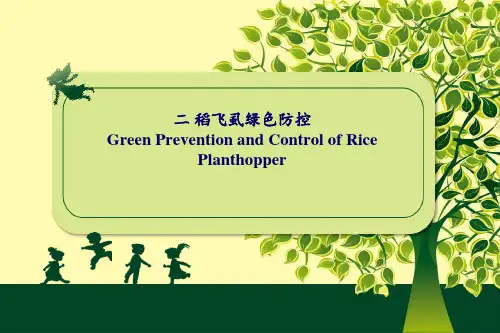
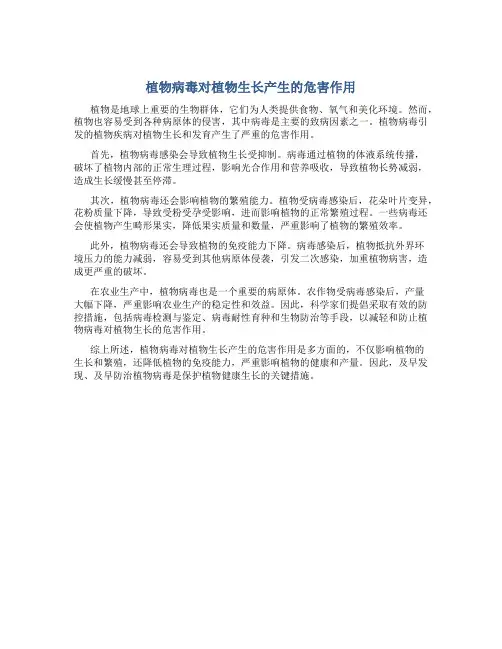
植物病毒对植物生长产生的危害作用
植物是地球上重要的生物群体,它们为人类提供食物、氧气和美化环境。
然而,植物也容易受到各种病原体的侵害,其中病毒是主要的致病因素之一。
植物病毒引发的植物疾病对植物生长和发育产生了严重的危害作用。
首先,植物病毒感染会导致植物生长受抑制。
病毒通过植物的体液系统传播,
破坏了植物内部的正常生理过程,影响光合作用和营养吸收,导致植物长势减弱,造成生长缓慢甚至停滞。
其次,植物病毒还会影响植物的繁殖能力。
植物受病毒感染后,花朵叶片变异,花粉质量下降,导致受粉受孕受影响,进而影响植物的正常繁殖过程。
一些病毒还会使植物产生畸形果实,降低果实质量和数量,严重影响了植物的繁殖效率。
此外,植物病毒还会导致植物的免疫能力下降。
病毒感染后,植物抵抗外界环
境压力的能力减弱,容易受到其他病原体侵袭,引发二次感染,加重植物病害,造成更严重的破坏。
在农业生产中,植物病毒也是一个重要的病原体。
农作物受病毒感染后,产量
大幅下降,严重影响农业生产的稳定性和效益。
因此,科学家们提倡采取有效的防控措施,包括病毒检测与鉴定、病毒耐性育种和生物防治等手段,以减轻和防止植物病毒对植物生长的危害作用。
综上所述,植物病毒对植物生长产生的危害作用是多方面的,不仅影响植物的
生长和繁殖,还降低植物的免疫能力,严重影响植物的健康和产量。
因此,及早发现、及早防治植物病毒是保护植物健康生长的关键措施。
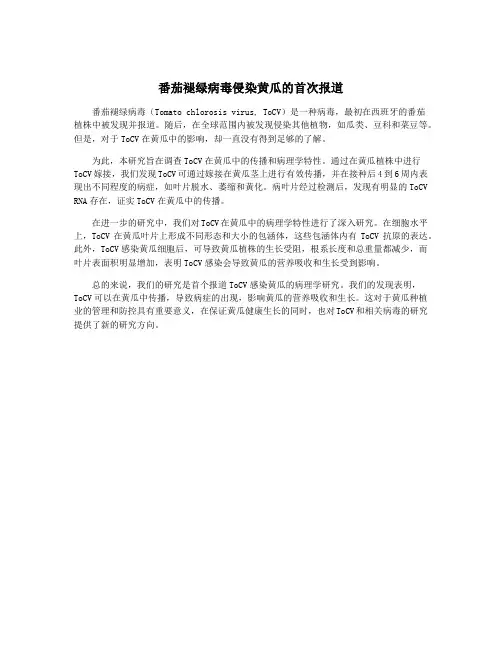
番茄褪绿病毒侵染黄瓜的首次报道
番茄褪绿病毒(Tomato chlorosis virus, ToCV)是一种病毒,最初在西班牙的番茄
植株中被发现并报道。
随后,在全球范围内被发现侵染其他植物,如瓜类、豆科和菜豆等。
但是,对于ToCV在黄瓜中的影响,却一直没有得到足够的了解。
为此,本研究旨在调查ToCV在黄瓜中的传播和病理学特性。
通过在黄瓜植株中进行ToCV嫁接,我们发现ToCV可通过嫁接在黄瓜茎上进行有效传播,并在接种后4到6周内表现出不同程度的病症,如叶片脱水、萎缩和黄化。
病叶片经过检测后,发现有明显的ToCV RNA存在,证实ToCV在黄瓜中的传播。
在进一步的研究中,我们对ToCV在黄瓜中的病理学特性进行了深入研究。
在细胞水平上,ToCV在黄瓜叶片上形成不同形态和大小的包涵体,这些包涵体内有ToCV抗原的表达。
此外,ToCV感染黄瓜细胞后,可导致黄瓜植株的生长受阻,根系长度和总重量都减少,而叶片表面积明显增加,表明ToCV感染会导致黄瓜的营养吸收和生长受到影响。
总的来说,我们的研究是首个报道ToCV感染黄瓜的病理学研究。
我们的发现表明,ToCV可以在黄瓜中传播,导致病症的出现,影响黄瓜的营养吸收和生长。
这对于黄瓜种植业的管理和防控具有重要意义,在保证黄瓜健康生长的同时,也对ToCV和相关病毒的研究提供了新的研究方向。
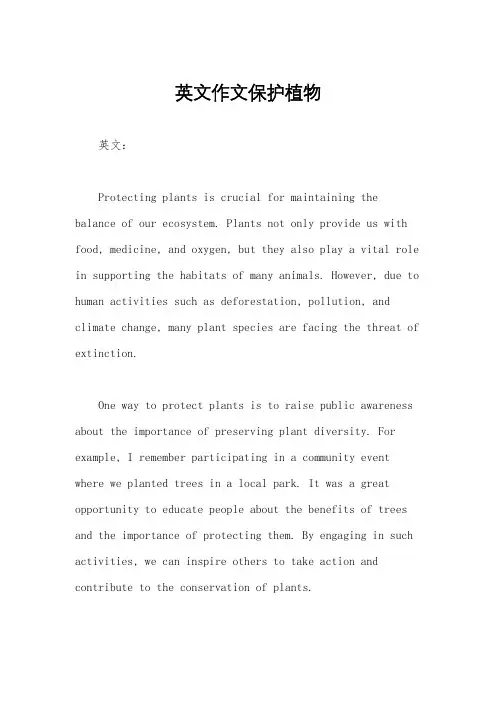
英文作文保护植物英文:Protecting plants is crucial for maintaining the balance of our ecosystem. Plants not only provide us with food, medicine, and oxygen, but they also play a vital role in supporting the habitats of many animals. However, due to human activities such as deforestation, pollution, and climate change, many plant species are facing the threat of extinction.One way to protect plants is to raise public awareness about the importance of preserving plant diversity. For example, I remember participating in a community event where we planted trees in a local park. It was a great opportunity to educate people about the benefits of trees and the importance of protecting them. By engaging in such activities, we can inspire others to take action and contribute to the conservation of plants.Another effective way to protect plants is through the establishment of protected areas and conservation programs. For instance, I recently visited a botanical garden that was dedicated to preserving rare and endangered plant species. The garden not only served as a sanctuary for these plants but also provided educational programs for visitors to learn about the significance of plant conservation.In addition, sustainable practices such as sustainable agriculture and responsible harvesting of plant resources are essential for protecting plants. By promoting sustainable methods of farming and harvesting, we can minimize the negative impact on plant populations and ensure their long-term survival.中文:保护植物对于维持生态系统的平衡至关重要。
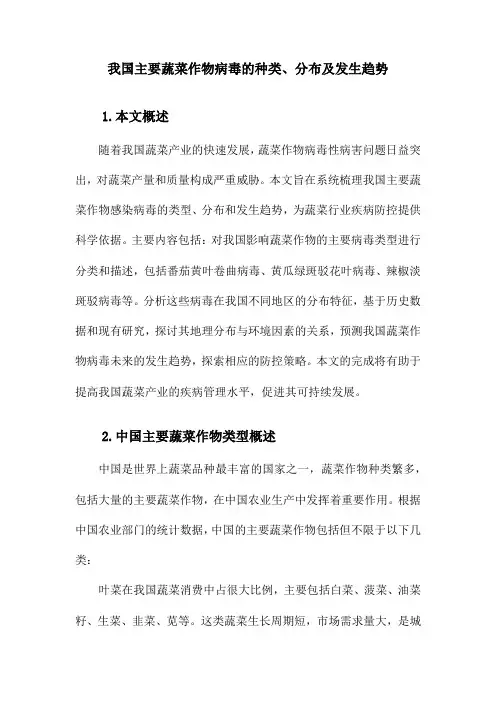
我国主要蔬菜作物病毒的种类、分布及发生趋势1.本文概述随着我国蔬菜产业的快速发展,蔬菜作物病毒性病害问题日益突出,对蔬菜产量和质量构成严重威胁。
本文旨在系统梳理我国主要蔬菜作物感染病毒的类型、分布和发生趋势,为蔬菜行业疾病防控提供科学依据。
主要内容包括:对我国影响蔬菜作物的主要病毒类型进行分类和描述,包括番茄黄叶卷曲病毒、黄瓜绿斑驳花叶病毒、辣椒淡斑驳病毒等。
分析这些病毒在我国不同地区的分布特征,基于历史数据和现有研究,探讨其地理分布与环境因素的关系,预测我国蔬菜作物病毒未来的发生趋势,探索相应的防控策略。
本文的完成将有助于提高我国蔬菜产业的疾病管理水平,促进其可持续发展。
2.中国主要蔬菜作物类型概述中国是世界上蔬菜品种最丰富的国家之一,蔬菜作物种类繁多,包括大量的主要蔬菜作物,在中国农业生产中发挥着重要作用。
根据中国农业部门的统计数据,中国的主要蔬菜作物包括但不限于以下几类:叶菜在我国蔬菜消费中占很大比例,主要包括白菜、菠菜、油菜籽、生菜、韭菜、苋等。
这类蔬菜生长周期短,市场需求量大,是城乡居民日常饮食的重要组成部分。
我国也广泛种植茄子和果菜,主要有茄子、西红柿、辣椒等。
这些蔬菜富含维生素和矿物质,深受消费者喜爱。
瓜类蔬菜在中国也占有重要地位,包括黄瓜、冬瓜、南瓜、丝瓜、苦瓜等。
这些蔬菜水分含量高,口感清爽,是夏季散热的好选择。
根茎类蔬菜主要有萝卜、胡萝卜、土豆、莲藕等。
这些蔬菜富含淀粉和纤维,营养价值高,是人们日常饮食中不可或缺的一部分。
豆类蔬菜包括青豆、豇豆、扁豆、豌豆等。
这些蔬菜蛋白质含量高,是植物蛋白质的重要来源。
葱蒜类蔬菜,如葱、葱、蒜等,在中国菜中有着独特的地位,是调味和增香的重要原料。
总体而言,中国主要蔬菜作物品种丰富多样,既满足了国内市场的需求,也促进了农业经济的发展。
随着病毒性疾病的频繁发生,这些蔬菜作物的安全生产也面临严峻挑战。
3.感染蔬菜作物的病毒类型我国是蔬菜生产大国,蔬菜品种繁多,病毒感染是影响蔬菜产量和品质的重要因素。
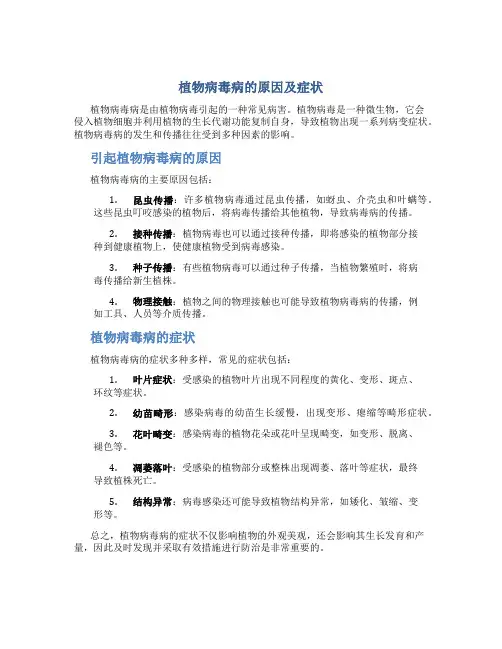
植物病毒病的原因及症状植物病毒病是由植物病毒引起的一种常见病害。
植物病毒是一种微生物,它会侵入植物细胞并利用植物的生长代谢功能复制自身,导致植物出现一系列病变症状。
植物病毒病的发生和传播往往受到多种因素的影响。
引起植物病毒病的原因植物病毒病的主要原因包括:1.昆虫传播:许多植物病毒通过昆虫传播,如蚜虫、介壳虫和叶螨等。
这些昆虫叮咬感染的植物后,将病毒传播给其他植物,导致病毒病的传播。
2.接种传播:植物病毒也可以通过接种传播,即将感染的植物部分接种到健康植物上,使健康植物受到病毒感染。
3.种子传播:有些植物病毒可以通过种子传播,当植物繁殖时,将病毒传播给新生植株。
4.物理接触:植物之间的物理接触也可能导致植物病毒病的传播,例如工具、人员等介质传播。
植物病毒病的症状植物病毒病的症状多种多样,常见的症状包括:1.叶片症状:受感染的植物叶片出现不同程度的黄化、变形、斑点、环纹等症状。
2.幼苗畸形:感染病毒的幼苗生长缓慢,出现变形、瘪缩等畸形症状。
3.花叶畸变:感染病毒的植物花朵或花叶呈现畸变,如变形、脱离、褪色等。
4.凋萎落叶:受感染的植物部分或整株出现凋萎、落叶等症状,最终导致植株死亡。
5.结构异常:病毒感染还可能导致植物结构异常,如矮化、皱缩、变形等。
总之,植物病毒病的症状不仅影响植物的外观美观,还会影响其生长发育和产量,因此及时发现并采取有效措施进行防治是非常重要的。
以上就是有关植物病毒病的原因和症状的简要介绍,希望对大家有所帮助。
如果你注意到了植物身上出现异常症状,建议及时请专业园艺人员进行检查和诊断,以制定有效的防治措施。
第29期报纸文章学习第一篇Watch plants fight for sunlight“Plants are the basis of all life, including ourselves. We depend upon (依赖) them for every mouth of food that we eat and every lungful (一大口) of air that we breathe.”David Attenborough said this at the beginning of The Green Planet (《绿色星球》), a BBC documentary series about plants. He’s right. It is plants that bring us fruits and vegetables. Plants also give us the oxygen (氧气) we need.But do you know enough about plants? The Green Planet shows the secret (秘密的) lives of plants as we have never seen before. Though they can’t walk or talk, they act like animals in many ways.FightingPlants fight against each other to live. In tropical (热带的) forests, they fight for sunlight. The forest floor is like a battlefield (战场). Only two percent of the sunlight gets to it, according to the series. A Monstera (龟背竹属植物) spreads (伸展) its big leaves to reach sunlight. At the same time, a vine (藤本植物) catches it to get a ride. But a balsa (轻木) tree wins over both of them because it grows faster.Helping each otherPlants also help each other and even communicate. In deserts, the roots (根) of Euphrates poplar (胡杨) are connected (相连接的). If a tree finds water, it will share it with others through the roots. Studies also show that plants use fungus (真菌) in the soil (土壤) as a way to “talk” toeach other. It’s kind of like how Wi-Fi works. If a tomato plant gets a leaf disease (疾病), it tells nearby plants about it.DefendingEach kind of plant has its own ways to protect itself. Some trees make poisonous sap (有毒的汁液). Some flowers give off a bad smell. The documentary shows us a corpse flower. It grows a meter wide. Looking closely, it has whiskers (须) and teeth. Its petals (花瓣) are the color of blood. More dangerously, it gives off a pungent (刺鼻的) smell to keep animals away. Attenborough calls it “the pungent smell of death”.Why are plants important?Air·Plants take in carbon dioxide (二氧化碳) and make oxygen (氧气) humans and animals need. ·Plants make 98% of the oxygen we breathe.Food·The world’s food supply (供应) depends on about 150 plant species.·Just 12 plant species provide three-quarters of the world’s food.Water·Plants help clean water and reduce floods.·A mature (成熟的) evergreen (常绿的) tree can hold more than 15,000 liters of water per year, reducing the risk of flooding.Medicine·Some plants are useful as medicines.·About 60% of the world’s population relies on herbal (草本的) medicines.Habitat·Plants provide habitats for animals and humans.·Rainforests (雨林) only cover a small part of Earth’s surface, yet they contain (容纳) more than half of the known species of animals and plants.Climate·Plants balance our climate. They help take carbon dioxide out of the atmosphere, which can slow down global warming.Health·A 2015 study showed that indoor plants can reduce stress. Plants can also help you stay focused (精力集中的) and work efficiently.第二篇Switch off for a good sleepDo you play with your phone before bedtime? You may want to read a book instead. According to a US study, looking at screens at night can cause us to sleep poorly.In the evening, our bodies make melatonin (褪黑素). Melatonin helps us feel sleepy and relaxed. It’s an important part of our sleep cycle (周期). Our electronic screens stop that cycle from working normally (正常地).Why? Phones, computers and TVs make blue light. Blue light stops our bodies from making melatonin. Even just a little bit of blue light can have an effect (影响). Eight minutes of blue light can keep your brain (大脑) “awake” for another hour, according to the study. Even if you fall asleep, you may have lots of dreams. Your brain won’t have a good rest.It’s even worse if you play an exciting game before bed. Games make our hearts beat faster, so we have a harder time falling asleep.vThen, when we fall asleep, we don’t get enough “deep sleep”.Use these tips to get a good night’s sleep·Have a relaxing routine every night. Take a warm shower or read a book.·Sleep in a dark, quiet room that is not too warm or too cold.·Count sheep. It’s the oldest trick, and it can actually work!·Don’t eat a big meal or have caffeine. Instead, drink milk.·Don’t run around or exercise three hours before bedtime.。
自己怎么保护植物英语作文英文回答:How to Protect Plants Yourself。
Plants are essential to life on earth. They provide us with oxygen, food, and medicine. They also help to cleanthe air and water. However, plants are under threat from a variety of factors, including climate change, pollution,and invasive species.There are a number of things you can do to help protect plants. Here are a few tips:Plant native species. Native plants are adapted to the local climate and soil conditions, so they are more likelyto thrive and survive.Choose plants that are resistant to pests and diseases. This will help to reduce the need for pesticides andherbicides.Water your plants regularly. Plants need water to grow and survive.Fertilize your plants according to the instructions on the packaging. Fertilizers provide plants with thenutrients they need to grow healthy.Protect your plants from pests and diseases. There are a number of natural ways to do this, such as using insecticidal soap or neem oil.Keep your garden clean. This will help to reduce the risk of pests and diseases.Compost your yard waste. Compost provides plants with nutrients and helps to improve the soil structure.Educate yourself about plants. The more you know about plants, the better you will be able to care for them.By following these tips, you can help to protect plants and ensure that they continue to provide us with the many benefits they offer.中文回答:如何自己保护植物。
研究植物计划用英语作文英文回答:Studying plants is a fascinating and rewarding endeavor. Plants play a crucial role in our ecosystem, providing oxygen, food, and shelter for countless organisms. As aplant researcher, I have the opportunity to explore the intricate mechanisms of plant growth, development, and response to environmental stimuli.One of the most interesting aspects of studying plantsis observing their adaptability to different conditions.For example, some plants have developed mechanisms tosurvive in extreme climates, such as deserts or arctic regions. By studying these plants, we can gain insightsinto how they have evolved to thrive in challenging environments.Another fascinating area of research is plant communication. Yes, you heard that right – plants cancommunicate with each other! Through chemical signals and even underground networks of fungi, plants can warn each other of impending threats, such as insect attacks. This phenomenon, known as plant communication, highlights the complexity and interconnectedness of the natural world.In addition to their biological significance, plantsalso hold cultural and economic importance. For example, many societies have relied on plants for medicinal purposes for centuries. By studying the chemical compounds in plants, researchers can discover new drugs and treatments for various diseases.Overall, studying plants is not only intellectually stimulating but also has real-world applications. Whetherit's developing drought-resistant crops or uncovering the secrets of plant communication, plant research has the potential to revolutionize agriculture, medicine, and environmental conservation.中文回答:研究植物是一项迷人且有意义的工作。
病原菌侵染拟南芥实验报告一、实验目的本实验旨在研究拟南芥植株对病原菌侵染的反应,以及病原菌在植株内的传播和病变的形成过程。
二、实验材料和方法1.实验材料- 拟南芥(Arabidopsis thaliana)植株- 病原菌 Pseudomonas syringae pv. tomato DC3000(Pst DC3000)2.实验方法2.1植物处理选择生长良好的拟南芥植株,将其放置在恒温箱中以25℃、16小时白天和8小时夜间的光照条件下生长。
在生长到6周大的拟南芥植株上进行病原菌的侵染。
2.2病原菌培养将Pst DC3000菌株从-80℃的细菌保存液中取出,接种在LB琼脂培养基上,37℃孵育过夜。
随后,取一小团菌落接种到新的LB琼脂培养基中,37℃孵育过夜。
第二天,将培养基中的菌落用生理盐水悬浮,并通过液体LB培养至菌液浓度为OD600 = 0.1,做为病原菌侵染拟南芥植株的菌液。
2.3植株侵染在全光下,将6周大的拟南芥植株的叶片上面涂抹几滴病原菌液。
在每组实验中,至少要选取5个独立的植株进行侵染。
在侵染后的植株上标记,并继续生长至一周。
2.4组织采集与样品处理侵染后1周,使用无菌的镊子取下侵染叶片,同时用无菌的刀片从植株的叶片上刮下菌液。
然后将叶片置于1%(w/v)的双氧水溶液中,进行1分钟的漂洗,以清除植物表面附着的细菌。
接着将叶片平放在滤纸上,以去除表面的水分。
处理后的叶片分别置于低温冰箱(-80℃)或液氮中保存。
三、实验结果将侵染后的拟南芥叶片制作成切片,用荧光显微镜观察病原菌的侵染情况。
观察到病原菌在叶片上形成黄绿色发光的斑点,这表明病原菌与拟南芥发生了交互作用。
此外,还观察到在侵染的植物组织中出现了细胞壁增厚和细胞死亡现象。
四、实验讨论和结论通过观察拟南芥植株对病原菌的反应,我们可以得出以下结论:1.拟南芥植株在病原菌侵染下,会产生抗病反应,如细胞壁增厚和细胞死亡。
这是拟南芥植物自身免疫系统的一种反应,旨在限制病原菌的传播和病变的扩展。
Unit 4 Green world Speaking1. in a corner of your balcony 在你阳台的角落2. the stages of growing soybeans 种大豆的步骤3. a bunch of flowers 一束花Reading1. a branch of medicine 医学的分支2. make attempts to do sth 尝试做某事3. classify…into…把…分类成…4. the identification of different species 鉴别不同物种5. be based on 以…为依据6. at first sight 第一眼7. conquer the world 征服世界8. develop a lifelong friendship with sb 和…成为终身的朋友9. have an appetite for knowledge 对知识的渴望10. lead a cosy life 过着舒适的生活11. appoint sb as…任命某人为…12. according to the instructions 根据指示13. on the three-year voyage 在三年的航海中14. calculate the distance between 计算距离15. be calculated to do sth 旨在,打算做某事16. the purpose of the expedition 远征的目的17. look out for 小心,留意18. on a large scale 大规模的19. accumulate a great deal of knowledge 积累大量知识20. experiment with doing sth 试做某事21. the botanical garden 植物园22. promote sb to sth 提升某人23. involve sb in (doing ) sth 使某人参与某事24. procedure for sth 手续,步骤25. a group activity 集体活动26. supply sb with sth / supply sth to sb 向某人提供某物provide sb with sth / provide sth for sboffer sth to sb / offer sb sthlanguage study1. put together ( = accumulate) enough money 积累足够的钱2. living expenses 生活费用3. open a bank account 开银行帐户4. pass away 去世5. at one’s own expense 由某人自己负担费用6. as a reward for 作为…的报酬7. name after 以…命名Integrating skills1. in one’s youth 某人年轻时期2. deserve special attention 值得特别关注3. pass on from one generation to the next 从一代传到下一代4. the influence of environment upon plants 环境对植物的影响5. adapt to the new environment 适应新环境6. be of equal importance 同样重要7. the output of crops 农作物的产量8. in detail 详细地1. n. 程序,手续,步骤主席对开会的程序很熟悉。
Biochem.J.(2010)430,21–37(PrintedinGreatBritain)doi:10.1042/BJ2010037221REVIEWARTICLETrackingthegreeninvaders:advancesinimagingvirusinfectioninplants
JensTILSNER*andKarlJ.OPARKA†1*PlantPathologyDepartment,ScottishCropResearchInstitute,Invergowrie,DundeeDD25DA,U.K.,and†InstituteofMolecularPlantSciences,UniversityofEdinburgh,MayfieldRoad,EdinburghEH93JH,U.K.
Bioimagingcontributessignificantlytoourunderstandingofplantvirusinfections.Inthepresentreview,wedescribetechnicaladvancesthatenableimagingoftheinfectionprocessatpreviouslyunobtainablelevels.Wehighlighthowsuchnewadvancesinsubcellularimagingarecontributingtoadetaileddissectionofallstagesoftheviralinfectionprocess.Specifically,wefocuson:(i)theincreasinglydetailedlocalizationsofviralproteinsenabledbyadiversifyingpaletteofcellularmarkers;(ii)approachesusingfluorescencemicroscopyforthefunctionalanalysisofproteinsinvivo;(iii)theimagingof
viralRNAs;(iv)methodsthatbridgethegapbetweenopticalandelectronmicroscopy;and(v)methodsthatareblurringthedistinctionbetweenimagingandstructuralbiology.Wedescribetheadvantagesanddisadvantagesofsuchtechniquesandplacetheminthebroaderperspectiveoftheirutilityinanalysingplantvirusinfection.
Keywords:correlativemicroscopy,fluorescentprotein,invivointeraction,membranetopology,RNAimaging,super-resolution.
INTRODUCTIONInordertoinfectahostcellandtospreadsystemically,viralpathogenshavetousurp,manipulateandoverwhelmnumerousbiologicalprocesseswithincells.Theyoftenachievethiswithaminimalsetofmultifunctionalvirus-encodedproteins,aswellasthroughtherecruitmentofhostfactors[1–5].Mostofthese‘hijacked’processesarecompartmentalizedwithinthehostcell,andthusthevirusanditsgeneproductsbecomelocalizedtospecificsubcellularcompartmentsduringtheappropriatestagesofinfection,ofteninahighlydynamicmanner.Theabilitytovisualizetheseeventsandtheirensuingeffectonthehostcellhavegreatlyenhancedourunderstandingoftheinfectionprocess.Sincethe1950s,EM(electronmicroscopy),latercoupledtoimmunogolddetectionofspecificproteinsandRNA,hasbeenthemainstayofvirologicalapproaches,butisrestrictedtostaticsnapshotsoftheinfectionprocess.Furthermore,thelimitedaccessibilityofantigenicepitopesinsamplesembeddedandsectionedforEMmakesitdifficulttodetectless-abundantproteinsortoquantitativelyassignvisiblestructurestospecificbiomolecules[6].ThediscoveryofFPs(fluorescentproteins)re-introducedLM(lightmicroscopy)asamajortoolforcellbiologyintheearly1990s,andtodayfluorescencemicroscopyisoneofthecornerstonesofplantvirology.Initially,virus-expressedFPsweresimplyusedtomonitorthespreadofinfection[7,8],butplantvirologistsquicklystartedtoemploythemasfusionstovirus-encodedproteins.Nowadays,fluorescencemicroscopyisusedincreasinglytopermitnotjustlocalization,butalso
functionalanalysisofproteinsinvivo,andnewapproacheshaveallowedoptical-basedmicroscopytobreakthediffractionbarrier,longheldasafixedlimittoresolution[9–11].Atthesametime,EMhasalsomadeimportantadvances,inparticularthroughimprovedsamplepreservationusinghigh-pressurefreezing/freezesubstitution[12]andtheextensioninto3D(three-dimensional)imagingusingET(electrontomography)[13,14].Consequently,correlativeapproachesthatcombineLMandEMarecurrentlybeingdevelopedinmanylaboratories[15,16].Cryo-EMtomographyandAFM(atomicforcemicroscopy)arestartingtoblurtheboundarybetweenimagingandstructuralbiology,andareopeningthedoortoatrulymolecularunderstandingoftheviralinfectionprocess.Inthepresentreview,wesummarizesomeoftheserecentdevelopmentswithaparticularfocusonthechallengesandadvantagesthatarespecifictoimagingplantvirusinfection.
ADVANCEMENTOFPROTEINLOCALIZATIONSTUDIESSincethefirstuseofGFP(greenFP)asareporterofvirusinfectioninplantcells[7],thepaletteofautofluorescentproteinsavailableforlocalizationstudieshasincreasedexponentiallythroughthediscoveryofnewnaturalsourceproteinsandtheengineeringofnewvarieties.Generally,newFPsareselectedtoincreasethenumberofspectralvariantsthatcanbeseparatedinco-localizationexperiments,andtoovercomeproblemswithphotostability,brightness,oligomerizationandfusiontolerance[17,18].Forplantvirusstudies,however,brightnessandphotostabilityareoftenlessimportantconsiderationsthanspectralpropertiesbecause
Abbreviationsused:3D,three-dimensional;AFM,atomicforcemicroscopy;BiFC,bimolecularfluorescencecomplementation;CFP,cyanfluorescentprotein;CLEM,correlativelightandelectronmicroscopy;COP,coatamerprotein;CP,capsidprotein;DAB,diaminobenzidine;dsRNA,double-strandedRNA;EM,electronmicroscopy;ER,endoplasmicreticulum;ET,electrontomography;EYFP,enhancedyellowfluorescentprotein;FlAsH,fluoresceinarsenicalhelixbinder;FLIM,fluorescencelifetimeimaging;FLIP,fluorescencelossinphotobleaching;FP,fluorescentprotein;FPC,C-terminalfragmentofsplitFP;FPN,N-terminalfragmentofsplitFP;FRAP,fluorescencerecoveryafterphotobleaching;FRET,fluorescenceresonanceenergytransfer;GFP,greenfluorescentprotein;LM,lightmicroscopy;MP,movementprotein;N,nucleocapsid;ORF,openreadingframe;PA,photoactivatable;PALM,photoactivationlocalizationmicroscopy;pc-FP,photoconvertiblefluorescentprotein;PD,plasmodesma(ta);PSF,point-spreadfunction;PUMHD,Pumiliohomologydomain;PVX,potatovirusX;Qdot,quantum-dot;ReAsH,resorufinarsenicalhelixbinder;RFP,redfluorescentprotein;RNP,ribonucleoproteinparticle;ROI,regionofinterest;SIM,structuredilluminationmicroscopy;STED,stimulatedemissiondepletion;STORM,stochasticopticalreconstructionmicroscopy;TGB,triplegeneblock;TMV,tobaccomosaicvirus;VRC,viralreplicationcentre;vRNA,viralRNA;YFP,yellowfluorescentprotein.1Towhomcorrespondenceshouldbeaddressed(emailkarl.oparka@ed.ac.uk).